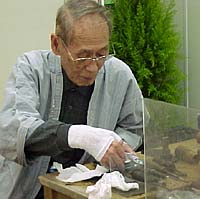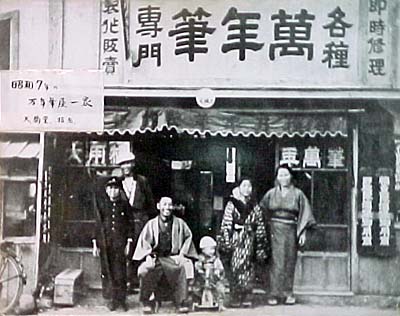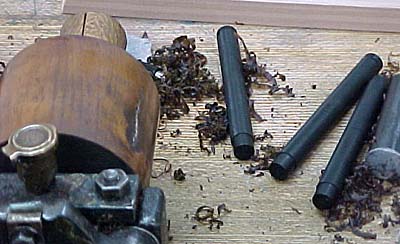Mr. Uehara of Ohashi-Do
By Russ Stutler and Mikiko Yamamoto
March, 2002
 One of the big attractions at the Mitsukoshi Spring Pen Fair was the presence of Mr. Eiichi Uehara, master pen craftsman from the Company Ohashi-Do. Mr. Uehara was born in 1919 in Tokyo (he is now 83 years old). He moved to Sendai city in 1928 with family. His Father was a fountain pen craftsman and opened a fountain pen shop in Sendai. He started making fountain pens at age 13, following his father's example. I am told he is the only person--or one of a very few persons--in Japan who makes the entire pen, both gold nib and ebonite barrel, all by himself.
One of the big attractions at the Mitsukoshi Spring Pen Fair was the presence of Mr. Eiichi Uehara, master pen craftsman from the Company Ohashi-Do. Mr. Uehara was born in 1919 in Tokyo (he is now 83 years old). He moved to Sendai city in 1928 with family. His Father was a fountain pen craftsman and opened a fountain pen shop in Sendai. He started making fountain pens at age 13, following his father's example. I am told he is the only person--or one of a very few persons--in Japan who makes the entire pen, both gold nib and ebonite barrel, all by himself.
 Hard at work on the foot-powered lathe
Hard at work on the foot-powered lathe |
His working studio is still located in Sendai. Now three pupils work with him to learn pen manufacturing. He also goes to several cities to have demonstration/sale sessions at different department stores. So there are many fans of his hand-made pens throughout the country. Each customer receives an invitation letter from him at least once every year for free adjustment/service of pens they bought from him.
About ten years ago, a very old pen was sent to him for repair. The client mentioned it was a father's favorite pen. The nib imprint read "Ohashi-do". It was revealed that the pen was made by Mr. Uehara's father at the end of Meiji era (probably in the 1910s).
 As a uniformed young boy (left) in front of his father's shop
As a uniformed young boy (left) in front of his father's shop Ebonite (Hard Rubber) is still used for his pens as it was done at his father's shop in the pre-war era. It is a very hard material made of mixture of raw rubber, sulfur and carbon. The entire manufacturing process of his pens is by hand, as a result, only two or three pens can be made per day.
 Chased black ebonite rods with shavings that are actually brown
Chased black ebonite rods with shavings that are actually brown
Not many pens are made of ebonite these days, and the pens of Ohashi-Do are further distinguished in that they are coated with traditional Japanese "urushi" lacquer. Some have transparent coats, allowing the black hard rubber to shine through, and others are coated with colored urushi, and covered with original designs in the maki-e tradition. Each pen is unique--no two pens are even the same exact size!
 Some of the amazing urushi-coated pens on display.
Some of the amazing urushi-coated pens on display.Some of the pens with modern designs and colors are coated with what Mr. Uehara called non-genuine urushi. While the genuine urushi comes from trees naturally grown on the ground, the non-genuine version comes from trees grown by human hands in order to get urushi for the art and craft purpose. A woman at his table mentioned the latter type of urushi as "cultivated urushi".  I believe it's natural urushi, but the trees which produced it are grown artificially, perhaps with fertilizers and pesticides added to facilitate the growth. The woman showed us their high-end urushi pens in a color very similar the old Parker "Big-red." She said that the urushi applied on these pens comes from naturally grown urushi trees around 600 years old. I forgot the exact cost of these pens, but they were very expensive. On the other hand, the pen in brownish urushi with a natural ivory top, which I like, was said to be a non-genuine urushi pen. Still, I think it cost around 140,000 yen. If it had a 100% chemical based lacquer coating, it would not be so expensive. I believe it's natural urushi, but the trees which produced it are grown artificially, perhaps with fertilizers and pesticides added to facilitate the growth. The woman showed us their high-end urushi pens in a color very similar the old Parker "Big-red." She said that the urushi applied on these pens comes from naturally grown urushi trees around 600 years old. I forgot the exact cost of these pens, but they were very expensive. On the other hand, the pen in brownish urushi with a natural ivory top, which I like, was said to be a non-genuine urushi pen. Still, I think it cost around 140,000 yen. If it had a 100% chemical based lacquer coating, it would not be so expensive.
Mr. Uehara holds a patent for his sliding gold ring on the pen barrel that allows you to shift the weight balance to suit your hand and the way you hold the pen. The man himself is a cultural treasure, having received a medal from the Emperor of Japan.
 When we visited his booth, the man turned out to be a very lively and jovial fellow, joking and laughing heartily at anything even remotely humorous. He explained how he made his pens, and let us examine a rod of ebonite roughly the diameter of a large pen, and about half a meter long. he also brought out an olive colored old ebonite rod to show us how badly they can discolor if not properly taken care of. I pulled out from my bag an old black chased hard rubber pen that I had bought for very cheap, and which was also a bit discolored. Mr. Uehara was thrilled to see such an old pen, so I decided to give it to him as a present. It was an honor for me that he accepted it, and in return, his assistant Mr. Kimura who at 30 years of age is also a pen master in his own right, put a rod of black chased ebonite on the lathe, and fashioned within a few minutes a sort of tube like object that screws apart in the middle, and had a blind cap and gold clip. If I put a nib and section in it, it would make a handsome pen, but I think I will just treasure as it is, a one of a kind holder for toothpicks or pencil leads or even a vial of spare ink! When we visited his booth, the man turned out to be a very lively and jovial fellow, joking and laughing heartily at anything even remotely humorous. He explained how he made his pens, and let us examine a rod of ebonite roughly the diameter of a large pen, and about half a meter long. he also brought out an olive colored old ebonite rod to show us how badly they can discolor if not properly taken care of. I pulled out from my bag an old black chased hard rubber pen that I had bought for very cheap, and which was also a bit discolored. Mr. Uehara was thrilled to see such an old pen, so I decided to give it to him as a present. It was an honor for me that he accepted it, and in return, his assistant Mr. Kimura who at 30 years of age is also a pen master in his own right, put a rod of black chased ebonite on the lathe, and fashioned within a few minutes a sort of tube like object that screws apart in the middle, and had a blind cap and gold clip. If I put a nib and section in it, it would make a handsome pen, but I think I will just treasure as it is, a one of a kind holder for toothpicks or pencil leads or even a vial of spare ink!
How to purchase a Pen from Ohashi-Do
Buy a plane ticket to Japan, find your way to Sendai, and walk in the store. If you don't want to go to Sendai, plan your next trip to Tokyo or another big city here around the Ohashi-Do pen event schedule at a department store found on this Web site. Ohashi-Do will not sell you a pen unless they can have face to face interaction with you. Since these pens are hand made, no two are alike, and they feel it is impossible to determine which is the perfect pen (in terms of balance, size, aesthetics, etc) for you without this personal interaction.
 My treasured gift, a shiney new black chased hard rubber uh, thing
My treasured gift, a shiney new black chased hard rubber uh, thing |



